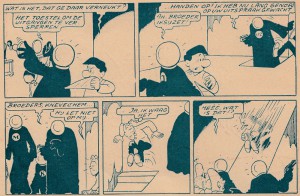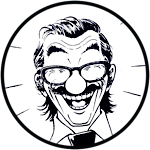In 1949, the Poperinge (Belgium) publisher Sansen released a comic by Bob De Moor called “Bloske & Zwik, Detectives” (read also: Bob De Moor’s most expensive album available now? A first edition from “Bloske en Zwik, Detectives” from 1949). The story itself had seen a pre-publication in ’t Kapoentje from December 6th, 1948, until April 28, 1949. Today we pick out 2 strips from this story, namely the first 2 ones from page 16 of the album. The scan comes from a mint copy Bob De Moor‘s nephew Ludo Van Looveren provided us.

The reason why we choose these 2 strips is because they resemble some of the antagonists we find back in the Tintin album “Cigars of the Pharaoh” (French: “Les Cigares du Pharaon”) by Hergé: hooded bandits. In both albums the hooded characters are part of a secret criminal society. In “Cigars of the Pharaoh” they are part of an international drug smuggling enterprise. In “Bloske & Zwik, Detectives” they are using the chemical factory Oxy & Co to abduct labourers and conduct radioactive experiments on them. In both albums a lot of the action happens in a secret underground facility. And just like in the Tintin album, the masked villains are in fact people everybody knows and never would have suspected in the first place.
Is this all a matter of coincidence? Maybe, but by 1948 Bob De Moor was already very familiar with the style of Hergé whose work he adored a lot, so it wouldn’t be to far fetched to think that John Van Looveren and Bob De Moor had loosely inspired their story on some of the elements we also find back in the famous Tintin album.
The “Cigars of the Pharaoh” album was the 4th album of the adventures of Tintin and was serialised weekly from December 1932 to February 1934 in the children’s supplement (Le Petit Vingtième) of the conservative Belgian newspaper Le Vingtième Siècle. In 1955, it was re-drawn (partially by Bob De Moor) and coloured in Hergé’s distinctive ligne-claire style for republication by Casterman.
On a side-note, the language used in “Bloske & Zwik, Detectives” and more precisely in the 2 strips we publish here is rather archaic, but that’s how (Flemish) Dutch was written back then. Some words have even completely disappeared in written or spoken language. For instance the first case features the verb ‘verneuken’ (english for what literally means ‘to cheat’) which later on would get such a negative sexual connotation (the origin of the verb being ‘neuken’ which stands for having sexual intercourse but said in a very rude way as if you would use ‘to fuck’) that it was preferred to no longer use it, especially in teen comics.
